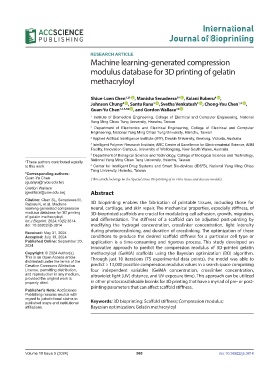Page 568 - IJB-10-5
P. 568
International
Journal of Bioprinting
RESEARCH ARTICLE
Machine learning-generated compression
modulus database for 3D printing of gelatin
methacryloyl
Shiue-Luen Chen 1,2† id , Manisha Senadeera 3† id , Kalani Ruberu 4 id ,
Johnson Chung 4 id , Santu Rana 3 id ,Svetha Venkatesh 3 id , Chong-You Chen 1,2 id ,
* , and Gordon Wallace *
Guan-Yu Chen 1,2,5,6 id 4 id
1 Institute of Biomedical Engineering, College of Electrical and Computer Engineering, National
Yang Ming Chiao Tung University, Hsinchu, Taiwan
2 Department of Electronics and Electrical Engineering, College of Electrical and Computer
Engineering, National Yang Ming Chiao Tung University, Hsinchu, Taiwan
3 2 2
Applied Artificial Intelligence Institute (A I ), Deakin University, Geelong, Victoria, Australia
4 Intelligent Polymer Research Institute, ARC Centre of Excellence for Electromaterial Science, AIIM
Facility, Innovation Campus, University of Wollongong, New South Wales, Australia
5 Department of Biological Science and Technology, College of Biological Science and Technology,
† These authors contributed equally National Yang Ming Chiao Tung University, Hsinchu, Taiwan
to this work. 6 Center for Intelligent Drug Systems and Smart Bio-devices (IDS B), National Yang Ming Chiao
2
Tung University, Hsinchu, Taiwan
*Corresponding authors:
Guan-Yu Chen (This article belongs to the Special Issue: Bioprinting of in vitro tissue and disease models)
(guanyu@nycu.edu.tw)
Gordon Wallace
(gwallace@uow.edu.au) Abstract
Citation: Chen SL, Senadeera M,
Ruberu K, et al. Machine 3D bioprinting enables the fabrication of printable tissues, including those for
learning-generated compression neural, cartilage, and skin repair. The mechanical properties, especially stiffness, of
modulus database for 3D printing 3D-bioprinted scaffolds are crucial for modulating cell adhesion, growth, migration,
of gelatin methacryloyl.
Int J Bioprint. 2024;10(5):3814. and differentiation. The stiffness of a scaffold can be adjusted post-printing by
doi: 10.36922/ijb.3814 modifying the hydrogel concentration, crosslinker concentration, light intensity
during photocrosslinking, and duration of crosslinking. The optimization of these
Received: May 31, 2024
Accepted: July 19, 2024 conditions to produce the desired scaffold stiffness for a particular cell type or
Published Online: September 20, application is a time-consuming and rigorous process. This study developed an
2024 innovative approach to predict the compression modulus of 3D-printed gelatin
Copyright: © 2024 Author(s). methacryloyl (GelMA) scaffolds using the Bayesian optimization (BO) algorithm.
This is an Open Access article Through just 10 iterations (75 experimental data points), the model was able to
distributed under the terms of the
Creative Commons Attribution predict > 13,000 possible compression modulus values in a search space comprising
License, permitting distribution, four independent variables (GelMA concentration, crosslinker concentration,
and reproduction in any medium, ultraviolet light [UV] distance, and UV exposure time). This approach can be utilized
provided the original work is
properly cited. in other photocrosslinkable bioinks for 3D printing that have a myriad of pre- or post-
printing parameters that can affect scaffold stiffness.
Publisher’s Note: AccScience
Publishing remains neutral with
regard to jurisdictional claims in
published maps and institutional Keywords: 3D bioprinting; Scaffold stiffness; Compression modulus;
affiliations. Bayesian optimization; Gelatin methacryloyl
Volume 10 Issue 5 (2024) 560 doi: 10.36922/ijb.3814

